Combined “Renewable Energy–Thermal Energy Storage (RE–TES)” Systems: A Review
Abstract
:1. Background
2. Types of Renewable Energy Sources
2.1. Solar Energy
2.2. Wind Energy
2.3. Biomass Energy
2.4. Geothermal Energy
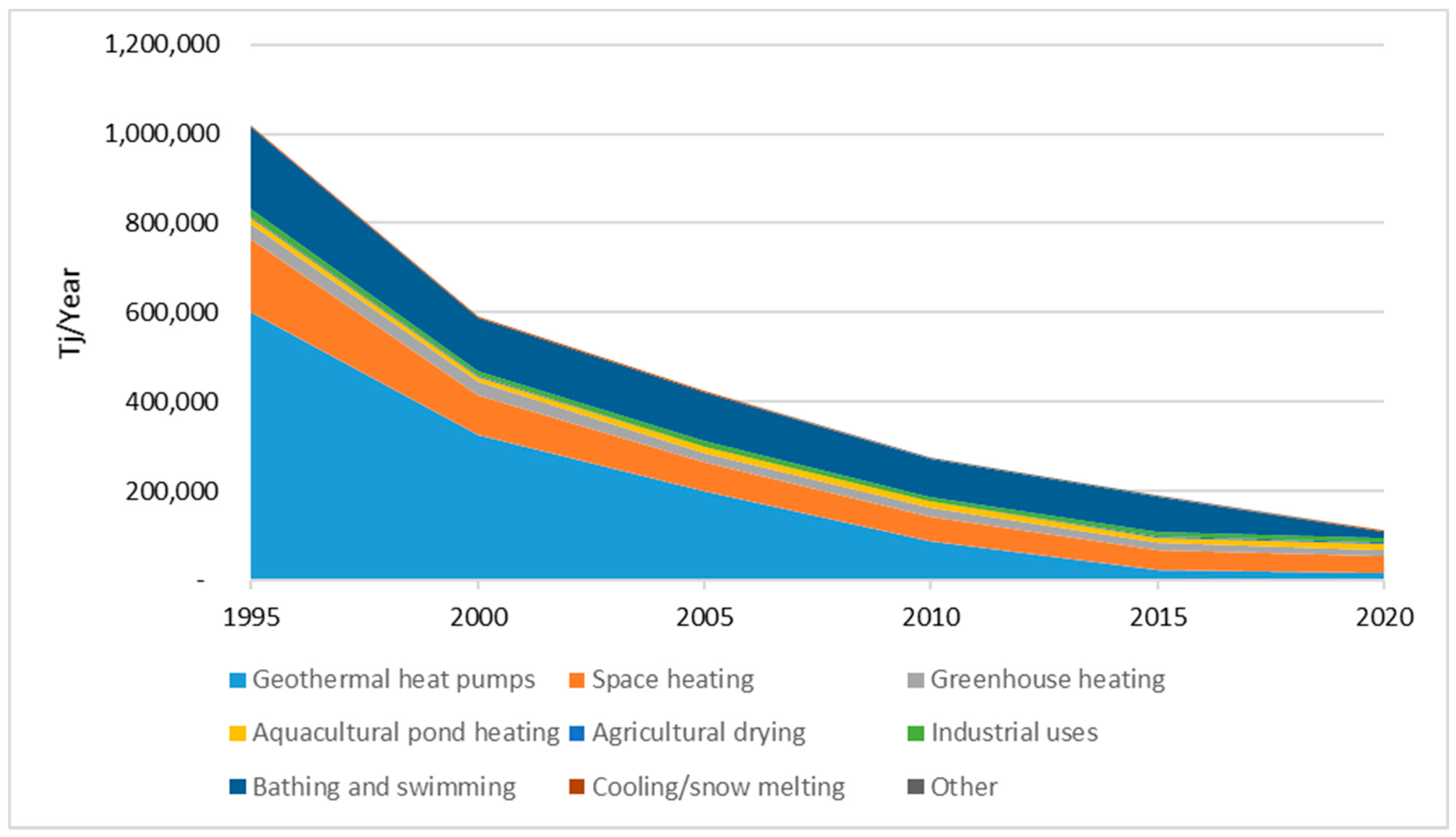
2.5. Ocean Energy
3. Energy Storage Systems
4. Thermal Energy Storage Systems
4.1. Sensible TES
4.2. Latent TES
4.3. Sorption TES
5. Combined Renewable Energy–Thermal Energy Storage Systems
5.1. Combined Solar/TES System
5.2. Combined Wind/TES System
5.3. Combined Biomass/TES System
5.4. Combined Geothermal/TES System
5.5. Combined Ocean/TES System
5.6. Renewable Polygeneration/TES System
6. Conclusions
Author Contributions
Funding
Data Availability Statement
Conflicts of Interest
References
- Wolniak, R.; Skotnicka-Zasadzien, B. Development of Photovoltaic Energy in EU Countries as an Alternative to Fossil Fuels. Energies 2022, 15, 662. [Google Scholar] [CrossRef]
- Amanatidis, G. Report: European Policies on Climate and Energy towards 2020, 2030 and 2050; Policy Department for Economic, Scientific and Quality of Life Policies; Directorate-General for Internal Policies: Brussels, Belgium, 2019. [Google Scholar]
- IRENA. Renewable Energy Solutions for Climate-Safe Cities. Available online: https://www.irena.org/News/articles/2020/Oct/Renewable-Energy-Solutions-for-Climate-Safe-Cities (accessed on 11 November 2022).
- Kini, V. Ingersoll Rand 2030 and 2050 Environmental Goals Set to Mitigate Climate Change and Make Life Better for Generations to Come. Available online: https://investors.irco.com/news/news-details/2021/Ingersoll-Rand-2030-and-2050-Environmental-Goals-Set-to-Mitigate-Climate-Change-and-Make-Life-Better-for-Generations-to-Come/default.aspx (accessed on 11 November 2022).
- Dincer, I.; Rosen, M.A. Energy Storage Systems. In Thermal Energy Storage: Systems and Applications, 3rd ed.; John Wiley & Sons: Hoboken, NJ, USA, 2021; pp. 59–123. [Google Scholar]
- Li, G. Sensible heat thermal storage energy and exergy performance evaluations. Renew. Sustain. Energy Rev. 2016, 53, 897–923. [Google Scholar] [CrossRef]
- Li, G. Energy and exergy performance assessments for latent heat thermal energy storage systems. Renew. Sustain. Energy Rev. 2015, 51, 926–954. [Google Scholar] [CrossRef]
- Liu, Y.L.; Wang, R.Z.; Xia, Z.Z. Experimental study on a continuous adsorption water chiller with novel design. Int. J. Refrig.-Rev. Int. Du Froid 2005, 28, 218–230. [Google Scholar] [CrossRef]
- Li, G.; Zheng, X.F. Thermal energy storage system integration forms for a sustainable future. Renew. Sustain. Energy Rev. 2016, 62, 736–757. [Google Scholar] [CrossRef]
- Kebede, A.A.; Kalogiannis, T.; Van Mierlo, J.; Berecibar, M. A comprehensive review of stationary energy storage devices for large scale renewable energy sources grid integration. Renew. Sustain. Energy Rev. 2022, 159, 112213. [Google Scholar] [CrossRef]
- Xu, J.; Wang, R.Z.; Li, Y. A review of available technologies for seasonal thermal energy storage. Sol. Energy 2014, 103, 610–638. [Google Scholar] [CrossRef]
- Koçak, B.; Fernandez, A.I.; Paksoy, H. Review on sensible thermal energy storage for industrial solar applications and sustainability aspects. Sol. Energy 2020, 209, 135–169. [Google Scholar] [CrossRef]
- Alva, G.; Liu, L.K.; Huang, X.; Fang, G.Y. Thermal energy storage materials and systems for solar energy applications. Renew. Sustain. Energy Rev. 2017, 68, 693–706. [Google Scholar] [CrossRef]
- Fleuchaus, P.; Schuppler, S.; Bloemendal, M.; Guglielmetti, L.; Opel, O.; Blum, P. Risk analysis of High-Temperature Aquifer Thermal Energy Storage (HT-ATES). Renew. Sustain. Energy Rev. 2020, 133, 110153. [Google Scholar] [CrossRef]
- Wang, G.H.; Yang, Y.A.; Wang, S.X. Ocean thermal energy application technologies for unmanned underwater vehicles: A comprehensive review. Appl. Energy 2020, 278, 115752. [Google Scholar] [CrossRef]
- Caralis, G.; Christakopoulos, T.; Karellas, S.; Gao, Z.Q. Analysis of energy storage systems to exploit wind energy curtailment in Crete. Renew. Sustain. Energy Rev. 2019, 103, 122–139. [Google Scholar] [CrossRef]
- Ali, U. Bloomberg New Energy Outlook 2019: The Future of the Energy Sector: Bloomberg New Energy Finance (BNEF) Held Its Annual New Energy Outlook (NEO). Available online: https://www.power-technology.com/news/bloomberg-new-energy-outlook-2019-2/ (accessed on 23 November 2022).
- BP, P.L.C. Statistical Review of World Energy: Primary Energy. Available online: https://www.bp.com/en/global/corporate/energy-economics/statistical-review-of-world-energy/primary-energy.html (accessed on 23 November 2022).
- Lichołai, L.; Kruzel, R.; Helbrych, P.; Dębska, B.; Miąsik, P.; Szyszka, J.; Krasoń, J.; Szalacha, A. Analysis of the profitability of a photovoltaic installation in the context of sustainable development of construction. E3S Web Conf. 2018, 49, 61. [Google Scholar]
- Mitscher, M.; Ruther, R. Economic performance and policies for grid-connected residential solar photovoltaic systems in Brazil. Energy Policy 2012, 49, 688–694. [Google Scholar] [CrossRef]
- Dinesh, H.; Pearce, J.M. The potential of agrivoltaic systems. Renew. Sustain. Energy Rev. 2016, 54, 299–308. [Google Scholar] [CrossRef]
- Patel, M.T.; Khan, M.R.; Sun, X.S.; Alam, M.A. A worldwide cost-based design and optimization of tilted bifacial solar farms. Appl. Energy 2019, 247, 467–479. [Google Scholar] [CrossRef]
- Saxena, A.; Goel, V. A Technical Note on Fabrication and Thermal Performance Studies of a Solar Pond Model. J. Renew. Energy 2013, 2013, 475282. [Google Scholar] [CrossRef]
- Perumal, P.; Dharmalingam, M. Solar ponds-a mini review. Environ. Sci. Pollut. Res. Int. 2022, 29, 45063–45069. [Google Scholar] [CrossRef]
- Ganguly, S.; Jain, R.; Date, A.; Akbarzadeh, A. On the addition of heat to solar pond from external sources. Sol. Energy 2017, 144, 111–116. [Google Scholar] [CrossRef]
- Moss, R.W.; Henshall, P.; Arya, F.; Shire, G.; Hyde, T.; Eames, P.C. Performance and operational effectiveness of evacuated flat plate solar collectors compared with conventional thermal, PVT and PV panels. Appl. Energy 2018, 216, 588–601. [Google Scholar] [CrossRef]
- Joardder, M.U.H.; Halder, P.K.; Rahim, M.A.; Masud, M.H. Solar Pyrolysis. In Clean Energy for Sustainable Development; Rasul, M.G., Azad, A.K., Sharma, S.C., Eds.; Academic Press: Cambridge, MA, USA, 2017; pp. 213–235. [Google Scholar]
- Fernández-García, A.; Zarza, E.; Valenzuela, L.; Pérez, M. Parabolic-trough solar collectors and their applications. Renew. Sustain. Energy Rev. 2010, 14, 1695–1721. [Google Scholar] [CrossRef]
- Gautam, A.; Saini, R.P. A review on technical, applications and economic aspect of packed bed solar thermal energy storage system. J. Energy Storage 2020, 27, 101046. [Google Scholar] [CrossRef]
- Dincer, I.; Rosen, M.A. Renewable Energy Systems with Thermal Energy Storage. In Thermal Energy Storage: Systems and Applications, 3rd ed.; John Wiley & Sons: Hoboken, NJ, USA, 2021; pp. 521–555. [Google Scholar]
- Jones, D. Global Electricity Review 2021. 2021. Available online: https://ember-climate.org/insights/research/global-electricity-review-2021/ (accessed on 1 February 2023).
- REN21. Renewables 2021: Global Status Report. 2021, p. 146. Available online: https://www.ren21.net/wp-content/uploads/2019/05/GSR2021_Full_Report.pdf (accessed on 1 February 2023).
- Komusanac, I.; Brindley, G.; Fraile, D.; Ramirez, L. Report: Wind Energy in Europe—2020 Statistics and the Outlook for 2021–2025. 2021, pp. 1–40. Available online: https://windeurope.org/intelligence-platform/product/wind-energy-in-europe-2020-statistics-and-the-outlook-for-2021-2025/ (accessed on 1 February 2023).
- Msigwa, G.; Ighalo, J.O.; Yap, P.S. Considerations on environmental, economic, and energy impacts of wind energy generation: Projections towards sustainability initiatives. Sci. Total Environ. 2022, 849, 157755. [Google Scholar] [CrossRef]
- Ulazia, A.; Nafarrate, A.; Ibarra-Berastegi, G.; Saenz, J.; Carreno-Madinabeitia, S. The Consequences of Air Density Variations over Northeastern Scotland for Offshore Wind Energy Potential. Energies 2019, 12, 2635. [Google Scholar] [CrossRef]
- Islam, S.; Dincer, I.; Yilbas, B.S. Analysis and Assessment of a Biomass Energy-Based Multigeneration System with Thermoelectric Generators. Energy Fuels 2017, 31, 10901–10915. [Google Scholar] [CrossRef]
- Tazi, N.; Bouzidi, Y. Evolution of wind energy pricing policies in France: Opportunities and new challenges. Energy Rep. 2020, 6, 687–692. [Google Scholar] [CrossRef]
- Diffendorfer, J.E.; Dorning, M.A.; Keen, J.R.; Kramer, L.A.; Taylor, R.V. Geographic context affects the landscape change and fragmentation caused by wind energy facilities. PeerJ 2019, 7, e7129. [Google Scholar] [CrossRef]
- Perold, V.; Ralston-Paton, S.; Ryan, P. On a collision course? The large diversity of birds killed by wind turbines in South Africa. Ostrich 2020, 91, 228–239. [Google Scholar] [CrossRef]
- KaradaĞ, İ.; KuruÇAy, E. Noise Emission from Building Integrated Wind Turbines: A Case Study of a Tall Building. Sak. Univ. J. Sci. 2021, 25, 563–570. [Google Scholar] [CrossRef]
- Kandasamy, S.; Devarayan, K.; Bhuvanendran, N.; Zhang, B.; He, Z.X.; Narayanan, M.; Mathimani, T.; Ravichandran, S.; Pugazhendhi, A. Accelerating the production of bio-oil from hydrothermal liquefaction of microalgae via recycled biochar-supported catalysts. J. Environ. Chem. Eng. 2021, 9, 105321. [Google Scholar] [CrossRef]
- Shanmugam, S.; Sekar, M.; Sivaramakrishnan, R.; Raj, T.; Ong, E.S.; Rabbani, A.H.; Rene, E.R.; Mathimani, T.; Brindhadevi, K.; Pugazhendhi, A. Pretreatment of second and third generation feedstock for enhanced biohythane production: Challenges, recent trends and perspectives. Int. J. Hydrogen Energy 2021, 46, 11252–11268. [Google Scholar] [CrossRef]
- Rezaei, M.; Sameti, M.; Nasiri, F. Biomass-fuelled combined heat and power: Integration in district heating and thermal-energy storage. Clean Energy 2021, 5, 44–56. [Google Scholar] [CrossRef]
- Whangchai, K.; Mathimani, T.; Sekar, M.; Shanmugam, S.; Brindhadevi, K.; Van Hung, T.; Chinnathambi, A.; Alharbi, S.A.; Pugazhendhi, A. Synergistic supplementation of organic carbon substrates for upgrading neutral lipids and fatty acids contents in microalga. J. Environ. Chem. Eng. 2021, 9, 105482. [Google Scholar] [CrossRef]
- Voloshin, R.A.; Rodionova, M.V.; Zharmulzhamedou, S.K.; Veziroglu, T.N.; Allakhverdiev, S.I. Review: Biofuel production from plant and algal biomass. Int. J. Hydrogen Energy 2016, 41, 17257–17273. [Google Scholar] [CrossRef]
- Saravanan, A.P.; Mathimani, T.; Deviram, G.; Rajendran, K.; Pugazhendhi, A. Biofuel policy in India: A review of policy barriers in sustainable marketing of biofuel. J. Clean. Prod. 2018, 193, 734–747. [Google Scholar] [CrossRef]
- Alagumalai, A.; Mathimani, T.; Pugazhendhi, A.; Atabani, A.E.; Brindhadevi, K.; Canh, N.D. Experimental insight into co-combustion characteristics of oxygenated biofuels in modified DICI engine. Fuel 2020, 278, 118303. [Google Scholar] [CrossRef]
- Deviram, G.; Mathimani, T.; Anto, S.; Ahamed, T.S.; Ananth, D.A.; Pugazhendhi, A. Applications of microalgal and cyanobacterial biomass on a way to safe, cleaner and a sustainable environment. J. Clean. Prod. 2020, 253, 119770. [Google Scholar] [CrossRef]
- Pal, P.; Chew, K.W.; Yen, H.W.; Lim, J.W.; Lam, M.K.; Show, P.L. Cultivation of Oily Microalgae for the Production of Third-Generation Biofuels. Sustainability 2019, 11, 5424. [Google Scholar] [CrossRef]
- Shokravi, H.; Heidarrezaei, M.; Shokravi, Z.; Ong, H.C.; Lau, W.J.; Din, M.F.M.; Ismail, A.F. Fourth generation biofuel from genetically modified algal biomass for bioeconomic development. J. Biotechnol. 2022, 360, 23–36. [Google Scholar] [CrossRef] [PubMed]
- Fushimi, C. Valorization of Biomass Power Generation System: Noble Use of Combustion and Integration with Energy Storage. Energy Fuels 2021, 35, 3715–3730. [Google Scholar] [CrossRef]
- Das, P.; Chandramohan, V.P.; Mathimani, T.; Pugazhendhi, A. Recent advances in thermochemical methods for the conversion of algal biomass to energy. Sci. Total Environ. 2021, 766, 144608. [Google Scholar] [CrossRef] [PubMed]
- Mathimani, T.; Baldinelli, A.; Rajendran, K.; Prabakar, D.; Matheswaran, M.; van Leeuwen, R.P.; Pugazhendhi, A. Review on cultivation and thermochemical conversion of microalgae to fuels and chemicals: Process evaluation and knowledge gaps. J. Clean. Prod. 2019, 208, 1053–1064. [Google Scholar] [CrossRef]
- Mathimani, T.; Mallick, N. A review on the hydrothermal processing of microalgal biomass to bio-oil—Knowledge gaps and recent advances. J. Clean. Prod. 2019, 217, 69–84. [Google Scholar] [CrossRef]
- Verma, D.; Fortunati, E.; Jain, S.; Zhang, X. Biomass, Biopolymer-Based Materials, and Bioenergy: Construction, Biomedical, and Other Industrial Applications; Woodhead Publishing: Duxford, UK, 2019. [Google Scholar]
- Lin, E.Y.; Lu, C.R.E. Development perspectives of promising lignocellulose feedstocks for production of advanced generation biofuels: A review. Renew. Sustain. Energy Rev. 2021, 136, 110445. [Google Scholar] [CrossRef]
- Glivin, G.; Sekhar, S.J. Experimental and Analytical Studies on the Utilization of Biowastes Available in an Educational Institution in India. Sustainability 2016, 8, 1128. [Google Scholar] [CrossRef]
- Glivin, G.; Sekhar, S.J. Waste Potential, Barriers and Economic Benefits of Implementing Different Models of Biogas Plants in a Few Indian Educational Institutions. Bioenergy Res. 2020, 13, 668–682. [Google Scholar] [CrossRef]
- Kumar, G.; Cho, S.K.; Sivagurunathan, P.; Anburajan, P.; Mahapatra, D.M.; Park, J.H.; Pugazhendhi, A. Insights into evolutionary trends in molecular biology tools in microbial screening for biohydrogen production through dark fermentation. Int. J. Hydrogen Energy 2018, 43, 19885–19901. [Google Scholar] [CrossRef]
- Chambon, C.L.; Karia, T.; Sandwell, P.; Hallett, J.P. Techno-economic assessment of biomass gasification-based mini-grids for productive energy applications: The case of rural India. Renew. Energy 2020, 154, 432–444. [Google Scholar] [CrossRef]
- Temiz, M.; Dincer, I. Concentrated solar driven thermochemical hydrogen production plant with thermal energy storage and geothermal systems. Energy 2021, 219, 119554. [Google Scholar] [CrossRef]
- Hu, Y.; Cheng, H.; Tao, S. Opportunity and challenges in large-scale geothermal energy exploitation in China. Crit. Rev. Environ. Sci. Technol. 2021, 52, 3813–3834. [Google Scholar] [CrossRef]
- Moya, D.; Aldas, C.; Kaparaju, P. Geothermal energy: Power plant technology and direct heat applications. Renew. Sustain. Energy Rev. 2018, 94, 889–901. [Google Scholar] [CrossRef]
- Zhang, L.; Chen, S.; Zhang, C. Geothermal power generation in China: Status and prospects. Energy Sci. Eng. 2019, 7, 1428–1450. [Google Scholar] [CrossRef]
- Dhar, A.; Naeth, M.A.; Jennings, P.D.; El-Din, M.G. Geothermal energy resources: Potential environmental impact and land reclamation. Environ. Rev. 2020, 28, 415–427. [Google Scholar] [CrossRef]
- Pan, S.Y.; Gao, M.Y.; Shah, K.J.; Zheng, J.M.; Pei, S.L.; Chiang, P.C. Establishment of enhanced geothermal energy utilization plans: Barriers and strategies. Renew. Energy 2019, 132, 19–32. [Google Scholar] [CrossRef]
- Sircar, A.; Bist, N.; Yadav, K.J.M.S. A comprehensive review on exploration and exploitation of offshore geothermal energy. Mar. Syst. Ocean Technol. 2022, 17, 135–146. [Google Scholar] [CrossRef]
- Lund, J.W.; Boyd, T.L. Direct utilization of geothermal energy 2015 worldwide review. Geothermics 2016, 60, 66–93. [Google Scholar] [CrossRef]
- Dalsgaard, J.; Lund, I.; Thorarinsdottir, R.; Drengstig, A.; Arvonen, K.; Pedersen, P.B. Farming different species in RAS in Nordic countries: Current status and future perspectives. Aquac. Eng. 2013, 53, 2–13. [Google Scholar] [CrossRef]
- Lund, J.W.; Toth, A.N. Direct utilization of geothermal energy 2020 worldwide review. Geothermics 2021, 90, 101915. [Google Scholar] [CrossRef]
- Morales-Nin, B.; Moranta, J.; Garcia, C.; Tugores, M.P.; Grau, A.M.; Riera, F.; Cerda, M. The recreational fishery off Majorca Island (western Mediterranean): Some implications for coastal resource management. Ices J. Mar. Sci. 2005, 62, 727–739. [Google Scholar] [CrossRef]
- Lim, C.C.; Cooper, C. Beyond Sustainability: Optimising Island Tourism Development. Int. J. Tour. Res. 2009, 11, 89–103. [Google Scholar] [CrossRef]
- Song, C.; Zhu, X.; Wang, M.; Yang, P.; Chen, L.; Hong, L.; Cui, W. Recent advances in ocean energy harvesting based on triboelectric nanogenerators. Sustain. Energy Technol. Assess. 2022, 53, 102767. [Google Scholar] [CrossRef]
- Alsvik, I.L.; Hagg, M.B. Pressure Retarded Osmosis and Forward Osmosis Membranes: Materials and Methods. Polymers 2013, 5, 303–327. [Google Scholar] [CrossRef]
- Li, M.; Luo, H.J.; Zhou, S.J.; Kumar, G.M.S.; Guo, X.M.; Law, T.C.; Cao, S.L. State-of-the-art review of the flexibility and feasibility of emerging offshore and coastal ocean energy technologies in East and Southeast Asia. Renew. Sustain. Energy Rev. 2022, 162, 112404. [Google Scholar] [CrossRef]
- Quirapas, M.A.J.R.; Lin, H.; Abundo, M.L.S.; Brahim, S.; Santos, D. Ocean renewable energy in Southeast Asia: A review. Renew. Sustain. Energy Rev. 2015, 41, 799–817. [Google Scholar] [CrossRef]
- Magagna, D.; Uihlein, A. Ocean energy development in Europe: Current status and future perspectives. Int. J. Mar. Energy 2015, 11, 84–104. [Google Scholar] [CrossRef]
- Reguero, B.G.; Losada, I.J.; Mendez, F.J. A global wave power resource and its seasonal, interannual and long-term variability. Appl. Energy 2015, 148, 366–380. [Google Scholar] [CrossRef]
- Zhang, Y.-l.; Lin, Z.; Liu, Q.-l. Marine renewable energy in China: Current status and perspectives. Water Sci. Eng. 2014, 7, 288–305. [Google Scholar]
- Samrat, N.H.; Ahmad, N.B.; Choudhury, I.A.; Taha, Z. Prospect of wave energy in Malaysia. In Proceedings of the 2014 IEEE 8th International Power Engineering and Optimization Conference (PEOCO2014), Langkawi, Malaysia, 24–25 March 2014. [Google Scholar]
- Kim, G.; Lee, M.E.; Lee, K.S.; Park, J.S.; Jeong, W.M.; Kang, S.K.; Soh, J.G.; Kim, H. An overview of ocean renewable energy resources in Korea. Renew. Sustain. Energy Rev. 2012, 16, 2278–2288. [Google Scholar] [CrossRef]
- Inger, R.; Attrill, M.J.; Bearhop, S.; Broderick, A.C.; James Grecian, W.; Hodgson, D.J.; Mills, C.; Sheehan, E.; Votier, S.C.; Witt, M.J.; et al. Marine renewable energy: Potential benefits to biodiversity? An urgent call for research. J. Appl. Ecol. 2009, 46, 1145–1153. [Google Scholar] [CrossRef]
- Babarit, A. Working Principles and Technologies of Wave Energy Conversion. In Wave Energy Conversion; Babarit, A., Ed.; Elsevier: Amsterdam, The Netherlands, 2017; pp. 99–151. [Google Scholar]
- Hendroko Setyobudi, R.; Syarif Arief, I.; Aria Pria Utama, I.K.; Hantoro, R.; Prananda, J.; Muhammad Megawan, A.; Danang Birowosuto, M.; Kala Mahaswa, R.; Jani, Y.; Vincēviča-Gaile, Z. Computational Fluid Dynamics (CFD) Simulation for Designing Mooring Bitts Position at the Barge for Wave Energy Conversion (WEC). E3S Web Conf. 2020, 190, 17. [Google Scholar]
- Barbosa, D.V.E.; Santos, A.L.G.; dos Santos, E.D.; Souza, J.A. Overtopping device numerical study: Openfoam solution verification and evaluation of curved ramps performances. Int. J. Heat Mass Transf. 2019, 131, 411–423. [Google Scholar] [CrossRef]
- Kim, S.S.; Lee, J.C.; Kang, D.; Lee, S.S. Motion characteristics of a floating wave energy converter with wave activating body type. Int. J. Nav. Archit. Ocean Eng. 2019, 11, 244–255. [Google Scholar] [CrossRef]
- Bricker, J.D.; Esteban, M.; Takagi, H.; Roeber, V. Economic feasibility of tidal stream and wave power in post-Fukushima Japan. Renew. Energy 2017, 114, 32–45. [Google Scholar] [CrossRef]
- Liu, Y.J.; Li, Y.; He, F.L.; Wang, H.F. Comparison study of tidal stream and wave energy technology development between China and some Western Countries. Renew. Sustain. Energy Rev. 2017, 76, 701–716. [Google Scholar] [CrossRef]
- Woo, M. Tidal Energy: The New Sustainable Resource. Available online: https://www.woodharbinger.com/tidal-energy-sustainable-resource/ (accessed on 1 February 2023).
- Roberts, A.; Thomas, B.; Sewell, P.; Khan, Z.; Balmain, S.; Gillman, J. Current tidal power technologies and their suitability for applications in coastal and marine areas. J. Ocean Eng. Mar. Energy 2016, 2, 227–245. [Google Scholar] [CrossRef]
- Rajagopalan, K.; Nihous, G.C. Estimates of global Ocean Thermal Energy Conversion (OTEC) resources using an ocean general circulation model. Renew. Energy 2013, 50, 532–540. [Google Scholar] [CrossRef]
- Faizal, M.; Ahmed, M.R. Experimental studies on a closed cycle demonstration OTEC plant working on small temperature difference. Renew. Energy 2013, 51, 234–240. [Google Scholar] [CrossRef]
- Liu, W.M.; Xu, X.J.; Chen, F.Y.; Liu, Y.J.; Li, S.Z.; Liu, L.; Chen, Y. A review of research on the closed thermodynamic cycles of ocean thermal energy conversion. Renew. Sustain. Energy Rev. 2020, 119, 109581. [Google Scholar] [CrossRef]
- Li, D.M.; Fan, C.C.; Zhang, C.B.; Chen, Y.P. Control strategy of load following for ocean thermal energy conversion. Renew. Energy 2022, 193, 595–607. [Google Scholar] [CrossRef]
- Khosravi, A.; Syri, S.; Assad, M.E.H.; Malekan, M. Thermodynamic and economic analysis of a hybrid ocean thermal energy conversion/photovoltaic system with hydrogen-based energy storage system. Energy 2019, 172, 304–319. [Google Scholar] [CrossRef]
- Arabkoohsar, A.; Sadi, M. Flywheel energy storage. In Mechanical Energy Storage Technologies; Arabkoohsar, A., Ed.; Academic Press: Cambridge, MA, USA, 2021; pp. 101–124. [Google Scholar]
- Dincer, I.; Rosen, M.A. Thermal Energy Storage Methods. In Thermal Energy Storage: Systems and Applications, 3rd ed.; John Wiley & Sons: Hoboken, NJ, USA, 2021; pp. 125–259. [Google Scholar]
- Dincer, I.; Rosen, M.A. Thermal Energy Storage: Systems and Applications, 3rd ed.; John Wiley & Sons: Hoboken, NJ, USA, 2021. [Google Scholar]
- Zhou, D.; Zhao, C.Y.; Tian, Y. Review on thermal energy storage with phase change materials (PCMs) in building applications. Appl. Energy 2012, 92, 593–605. [Google Scholar] [CrossRef]
- AlShafi, M.; Bicer, Y. Thermodynamic performance comparison of various energy storage systems from source-to-electricity for renewable energy resources. Energy 2021, 219, 119626. [Google Scholar] [CrossRef]
- Atalay, H. Assessment of energy and cost analysis of packed bed and phase change material thermal energy storage systems for the solar energy-assisted drying process. Sol. Energy 2020, 198, 124–138. [Google Scholar] [CrossRef]
- Başer, T.; Dong, Y.; Moradi, A.M.; Lu, N.; Smits, K.; Ge, S.; Tartakovsky, D.; McCartney, J.S. Role of Nonequilibrium Water Vapor Diffusion in Thermal Energy Storage Systems in the Vadose Zone. J. Geotech. Geoenvironmental Eng. 2018, 144, 1. [Google Scholar] [CrossRef]
- Diyoke, C.; Wu, C.F. Thermodynamic analysis of hybrid adiabatic compressed air energy storage system and biomass gasification storage (A-CAES plus BMGS) power system. Fuel 2020, 271, 117572. [Google Scholar] [CrossRef]
- Saxena, A.; Cuce, E.; Singh, D.B.; Cuce, P.M.; Gupta, P.; Suryavanshi, A.; Farrokhi, M.; El-Sebaii, A.A. A thermodynamic review on solar ponds. Sol. Energy 2022, 242, 335–363. [Google Scholar] [CrossRef]
- Senturk Acar, M.; Arslan, O. Energy and exergy analysis of solar energy-integrated, geothermal energy-powered Organic Rankine Cycle. J. Therm. Anal. Calorim. 2019, 137, 659–666. [Google Scholar] [CrossRef]
- Soni, N.; Sharma, D.; Rahman, M.M.; Hanmaiahgari, P.R.; Reddy, V.M. Mathematical Modeling of Solar Energy based Thermal Energy Storage for House Heating in Winter. J. Energy Storage 2021, 34, 102203. [Google Scholar] [CrossRef]
- Temiz, M.; Dincer, I. A unique ocean and solar based multigenerational system with hydrogen production and thermal energy storage for Arctic communities. Energy 2022, 239, 122126. [Google Scholar] [CrossRef]
- Zhang, X.F.; Yan, R.S.; Zeng, R.; Zhu, R.L.; Kong, X.Y.; He, Y.C.; Li, H.Q. Integrated performance optimization of a biomass-based hybrid hydrogen/thermal energy storage system for building and hydrogen vehicles. Renew. Energy 2022, 187, 801–818. [Google Scholar] [CrossRef]
- Dincer, I.; Dost, S. A perspective on thermal energy storage systems for solar energy applications. Int. J. Energy Res. 1996, 20, 547–557. [Google Scholar] [CrossRef]
- Bindra, H.; Betz, A.R.; Stallbaumer, E.M.; Ross, M.; Riley, G.A.; Morrow, J.A.; Huber, R.A.; Haque, M.R.; Chakraborty, P.P.; Adams, A.N.; et al. Heat and Mass Transfer in the Food, Energy, and Water Nexus—A Review. J. Heat Transf. 2020, 142, 090801. [Google Scholar]
- John, E.; Hale, M.; Selvam, P. Concrete as a thermal energy storage medium for thermocline solar energy storage systems. Sol. Energy 2013, 96, 194–204. [Google Scholar] [CrossRef]
- Picone, S.; Bloemendal, M.; Pellegrini, M.; Hoekstra, N.; Andreu Gallego, A.; Rodriguez Comins, J.; Murrel, A. Novel combinations of aquifer thermal energy storage with solar collectors, soil remediation and other types of geothermal energy systems. In Proceedings of the European Geothermal Congress, Hague, The Netherlands, 11–14 June 2019. [Google Scholar]
- Bu, X.; Jiang, K.; Guo, Z. Storing high temperature solar thermal energy in shallow depth artificial reservoir for space heating. Sci. Rep. 2022, 12, 19549. [Google Scholar] [CrossRef] [PubMed]
- Li, H.; Tao, Y.; Zhang, Y.; Fu, H. Two-objective optimization of a hybrid solar-geothermal system with thermal energy storage for power, hydrogen and freshwater production based on transcritical CO cycle. Renew. Energy 2022, 183, 51–66. [Google Scholar] [CrossRef]
- Ahmed, A.A.; Assadi, M.; Kalantar, A.; Sliwa, T.; Sapińska-Śliwa, A. A critical review on the use of shallow geothermal energy systems for heating and cooling purposes. Energies 2022, 15, 4281. [Google Scholar] [CrossRef]
- Romanov, D.; Leiss, B. Geothermal energy at different depths for district heating and cooling of existing and future building stock. Renew. Sustain. Energy Rev. 2022, 167, 112727. [Google Scholar] [CrossRef]
- Aquifer Thermal Energy Storage for Decarbonisation of Heating and Cooling: Overcoming Technical, Economic and Societal Barriers to UK Deployment (ATESHAC). Available online: https://www.imperial.ac.uk/earth-science/research/research-groups/ateshac/ (accessed on 24 February 2023).
- Khodabandeh, E.; Safaei, M.R.; Akbari, S.; Akbari, O.A.; Alrashed, A.A. Application of nanofluid to improve the thermal performance of horizontal spiral coil utilized in solar ponds: Geometric study. Renew. Energy 2018, 122, 1–16. [Google Scholar] [CrossRef]
- Sayegh, M.A.; Zwierzchowski, R.; Malicki, M.; Lipka, M.; Danielewicz, J.; Jouhara, H.; Kaźmierczak, B.; Kutyłowska, M.; Piekarska, K. Innovative model of trigeneration system generating desalinated water, hot and cold by using low grade heat recovery from nuclear reactor set in cascade of sorption devices. E3S Web Conf. 2019, 116, 00108. [Google Scholar]
- Ghaddar, N.K. Stratified Storage Tank Influence on Performance of Solar Water-Heating System Tested in Beirut. Renew. Energy 1994, 4, 911–925. [Google Scholar] [CrossRef]
- Atomistic Simulation & Energy Research Group. Thermal Energy Grid Storage (TEGS) Concept. Available online: https://ase.mit.edu/projects/thermal-energy-grid-storage-tegs/ (accessed on 1 December 2022).
- Amy, C.; Seyf, H.R.; Steiner, M.A.; Friedman, D.J.; Henry, A. Thermal energy grid storage using multi-junction photovoltaics. Energy Environ. Sci. 2019, 12, 334–343. [Google Scholar] [CrossRef]
- Cárdenas, B.; León, N. High temperature latent heat thermal energy storage: Phase change materials, design considerations and performance enhancement techniques. Renew. Sustain. Energy Rev. 2013, 27, 724–737. [Google Scholar] [CrossRef]
- Ndukwu, M.C.; Bennamoun, L.; Abam, F.I.; Eke, A.B.; Ukoha, D. Energy and exergy analysis of a solar dryer integrated with sodium sulfate decahydrate and sodium chloride as thermal storage medium. Renew. Energy 2017, 113, 1182–1192. [Google Scholar] [CrossRef]
- García-Romero, A.; Diarce, G.; Ibarretxe, J.; Urresti, A.; Sala, J.M. Influence of the experimental conditions on the subcooling of Glauber’s salt when used as PCM. Sol. Energy Mater. Sol. Cells 2012, 102, 189–195. [Google Scholar] [CrossRef]
- Chaouch, W.B.; Khellaf, A.; Mediani, A.; Slimani, M.E.; Loumani, A.; Hamid, A. Experimental investigation of an active direct and indirect solar dryer with sensible heat storage for camel meat drying in Saharan environment. Sol. Energy 2018, 174, 328–341. [Google Scholar] [CrossRef]
- Akgün, M.; Aydın, O.; Kaygusuz, K.J.E.C. Experimental study on melting/solidification characteristics of a paraffin as PCM. Energy Convers. Manag. 2007, 48, 669–678. [Google Scholar] [CrossRef]
- Degues, K.d.M.; Cypriano, M.G.; Coelho, K.B.; Luza, A.L.; Montedo, O.R.K.; de Castro, L.C.; Angioletto, E. Assessment of PCM-impregnated zeolite as a matrix for latent heat storage. Mater. Sci. Forum 2018, 912, 87–92. [Google Scholar] [CrossRef]
- Wang, Z.F.; Wu, J.N.; Lei, D.Q.; Liu, H.; Li, J.P.; Wu, Z.Y. Experimental study on latent thermal energy storage system with gradient porosity copper foam for mid-temperature solar energy application. Appl. Energy 2020, 261, 114472. [Google Scholar] [CrossRef]
- Zhang, Q.F.; Xia, T.F.; Zhang, Q.H.; Zhu, Y.C.; Zhang, H.Z.; Xu, F.; Sun, L.X.; Wang, X.D.; Xia, Y.P.; Lin, X.C.; et al. Biomass Homogeneity Reinforced Carbon Aerogels Derived Functional Phase-Change Materials for Solar-Thermal Energy Conversion and Storage. Energy Environ. Mater. 2023, 6, 1. [Google Scholar] [CrossRef]
- Al-Shannaq, R.; Farid, M.; Al-Muhtaseb, S.; Kurdi, J. Emulsion stability and cross-linking of PMMA microcapsules containing phase change materials. Sol. Energy Mater. Sol. Cells 2015, 132, 311–318. [Google Scholar] [CrossRef]
- Al-Shannaq, R.; Kurdi, J.; Al-Muhtaseb, S.; Dickinson, M.; Farid, M. Supercooling elimination of phase change materials (PCMs) microcapsules. Energy 2015, 87, 654–662. [Google Scholar] [CrossRef]
- Al-Shannaq, R.; Kurdi, J.; Al-Muhtaseb, S.; Farid, M. Innovative method of metal coating of microcapsules containing phase change materials. Sol. Energy 2016, 129, 54–64. [Google Scholar] [CrossRef]
- Ansari, J.A.; Al-Shannaq, R.; Kurdi, J.; Al-Muhtaseb, S.A.; Ikutegbe, C.A.; Farid, M.M. A Rapid Method for Low Temperature Microencapsulation of Phase Change Materials (PCMs) Using a Coiled Tube Ultraviolet Reactor. Energies 2021, 14, 7867. [Google Scholar] [CrossRef]
- Roberts, N.S.; Al-Shannaq, R.; Kurdi, J.; Al-Muhtaseb, S.A.; Farid, M.M. Efficacy of using slurry of metal-coated microencapsulated PCM for cooling in a micro-channel heat exchanger. Appl. Therm. Eng. 2017, 122, 11–18. [Google Scholar] [CrossRef]
- Cao, Y.; Weng, M.; Mahmoud, M.H.H.; Elnaggar, A.Y.; Zhang, L.; El Azab, I.H.; Chen, Y.; Huang, M.; Huang, J.; Sheng, X. Flame-retardant and leakage-proof phase change composites based on MXene/polyimide aerogels toward solar thermal energy harvesting. Adv. Compos. Hybrid Mater. 2022, 5, 1253–1267. [Google Scholar] [CrossRef]
- Shen, R.; Weng, M.; Zhang, L.; Huang, J.; Sheng, X. Biomass-based carbon aerogel/Fe3O4@PEG phase change composites with satisfactory electromagnetic interference shielding and multi-source driven thermal management in thermal energy storage. Compos. Part A Appl. Sci. Manuf. 2022, 163, 107248. [Google Scholar] [CrossRef]
- Cao, Y.; Zeng, Z.; Huang, D.; Chen, Y.; Zhang, L.; Sheng, X. Multifunctional phase change composites based on biomass/MXene-derived hybrid scaffolds for excellent electromagnetic interference shielding and superior solar/electro-thermal energy storage. Nano Res. 2022, 15, 8524–8535. [Google Scholar] [CrossRef]
- Fujii, S.; Nakagaki, T.; Kanematsu, Y.; Kikuchi, Y. Prospective life cycle assessment for designing mobile thermal energy storage system utilizing zeolite. J. Clean. Prod. 2022, 365, 132592. [Google Scholar] [CrossRef]
- Liu, C.; Cao, H.; Jin, S.; Bao, Y.; Cheng, Q.; Rao, Z. Synthesis and characterization of microencapsulated phase change material with phenol-formaldehyde resin shell for thermal energy storage. Sol. Energy Mater. Sol. Cells 2022, 243, 111789. [Google Scholar] [CrossRef]
- Matuszewska, D.; Kuta, M.; Olczak, P. Techno-Economic Assessment of Mobilized Thermal Energy Storage System Using Geothermal Source in Polish Conditions. Energies 2020, 13, 3404. [Google Scholar] [CrossRef]
- Meng, F.X.; Wang, E.H.; Zhang, B.; Zhang, F.J.; Zhao, C.L. Thermo-economic analysis of transcritical CO2 power cycle and comparison with Kalina cycle and ORC for a low-temperature heat source. Energy Convers. Manag. 2019, 195, 1295–1308. [Google Scholar] [CrossRef]
- ElBahloul, A.A.; Zeidan, E.-S.B.; El-Sharkawy, I.I.; Hamed, A.M.; Radwan, A. Recent advances in multistage sorption thermal energy storage systems. J. Energy Storage 2022, 45, 103683. [Google Scholar] [CrossRef]
- Paksoy, H.O.; Andersson, O.; Abaci, S.; Evliya, H.; Turgut, B. Heating and cooling of a hospital using solar energy coupled with seasonal thermal energy storage in an aquifer. Renew. Energy 2000, 19, 117–122. [Google Scholar] [CrossRef]
- Fei, L.; Yin, Y.J.; Yang, M.F.; Zhang, S.F.; Wang, C.X. Wearable solar energy management based on visible solar thermal energy storage for full solar spectrum utilization. Energy Storage Mater. 2021, 42, 636–644. [Google Scholar] [CrossRef]
- Boretti, A. Concentrated Solar Energy with Thermal Energy Storage for Hydrogen Production by Three-Step Thermochemical Water-Splitting Cycles. Energy Fuels 2021, 35, 10832–10840. [Google Scholar] [CrossRef]
- Al-Mashakbeh, A.S.; Al-Mashaqbeh, S.F.; Awwad, A.M.E.; Almaita, E.K. Design and Optimization of Wind Energy System installed in Rehab Gas Power Station Combined with Thermal Energy Grid Storage Multi-Junction Photovoltaics Mean in Mafraq, Jordan. Int. J. Renew. Energy Res. 2022, 12, 39–47. [Google Scholar]
- Karasu, H.; Dincer, I. Analysis and Efficiency Assessment of Direct Conversion of Wind Energy into Heat Using Electromagnetic Induction and Thermal Energy Storage. J. Energy Resour. Technol.-Trans. Asme 2018, 140, 71201. [Google Scholar] [CrossRef]
- Wang, K.; Satyro, M.A.; Taylor, R.; Hopke, P.K. Thermal energy storage tank sizing for biomass boiler heating systems using process dynamic simulation. Energy Build. 2018, 175, 199–207. [Google Scholar] [CrossRef]
- Arslan, O.; Arslan, A.E. Performance evaluation and multi-criteria decision analysis of thermal energy storage integrated geothermal district heating system. Process Saf. Environ. Prot. 2022, 167, 21–33. [Google Scholar] [CrossRef]
- Zhou, Y. Ocean energy applications for coastal communities with artificial intelligence a state-of-the-art review. Energy AI 2022, 10, 100189. [Google Scholar] [CrossRef]
- Boretti, A. The perspective of enhanced geothermal energy integration with concentrated solar power and thermal energy storage. Energy Storage 2022, 4, 1. [Google Scholar] [CrossRef]
- Assareh, E.; Assareh, M.; Alirahmi, S.M.; Jalilinasrabady, S.; Dejdar, A.; Izadi, M. An extensive thermo-economic evaluation and optimization of an integrated system empowered by solar-wind-ocean energy converter for electricity generation—Case study: Bandar Abas, Iran. Therm. Sci. Eng. Prog. 2021, 25, 100965. [Google Scholar] [CrossRef]
- Li, L.; Gao, Y.; Ning, D.Z.; Yuan, Z.M. Development of a constraint non-causal wave energy control algorithm based on artificial intelligence. Renew. Sustain. Energy Rev. 2021, 138, 110519. [Google Scholar] [CrossRef]
- Harish, V.S.K.V.; Kumar, A. A review on modeling and simulation of building energy systems. Renew. Sustain. Energy Rev. 2016, 56, 1272–1292. [Google Scholar] [CrossRef]
- Dahanayake, K.W.D.K.C.; Chow, C.L. Studying the potential of energy saving through vertical greenery systems: Using EnergyPlus simulation program. Energy Build. 2017, 138, 47–59. [Google Scholar] [CrossRef]
- Djamel, I.; Camara, M.B.; Dakyo, B. Offshore wind farms energy injection in the electrical grid-Lithium battery to mitigate power fluctuations. Int. J. Renew. Energy Res. 2015, 5, 1049–1061. [Google Scholar]
- Yu, H.; Helland, H.; Yu, X.; Gundersen, T.; Sin, G. Optimal design and operation of an Organic Rankine Cycle (ORC) system driven by solar energy with sensible thermal energy storage. Energy Convers. Manag. 2021, 244, 114494. [Google Scholar] [CrossRef]
- Bamooeifard, A. Future studies in Iran development plans for wind power, a system dynamics modeling approach. Renew. Energy 2020, 162, 1054–1064. [Google Scholar] [CrossRef]
- Zhou, Y.; Cao, S. Quantification of energy flexibility of residential net-zero-energy buildings involved with dynamic operations of hybrid energy storages and diversified energy conversion strategies. Sustain. Energy Grids Netw. 2020, 21, 100304. [Google Scholar] [CrossRef]
- Stritih, U.; Butala, V. Optimization of a thermal storage unit combined with a biomass boiler for heating buildings. Renew. Energy 2004, 29, 2011–2022. [Google Scholar] [CrossRef]
- Terziotti, L.T.; Sweet, M.L.; McLeskey, J.T. Modeling seasonal solar thermal energy storage in a large urban residential building using TRNSYS 16. Energy Build. 2012, 45, 28–31. [Google Scholar] [CrossRef]
- Elghamry, R.; Hassan, H. Impact a combination of geothermal and solar energy systems on building ventilation, heating and output power: Experimental study. Renew. Energy 2020, 152, 1403–1413. [Google Scholar] [CrossRef]
- Ciani Bassetti, M.; Consoli, D.; Manente, G.; Lazzaretto, A. Design and off-design models of a hybrid geothermal-solar power plant enhanced by a thermal storage. Renew. Energy 2018, 128, 460–472. [Google Scholar] [CrossRef]


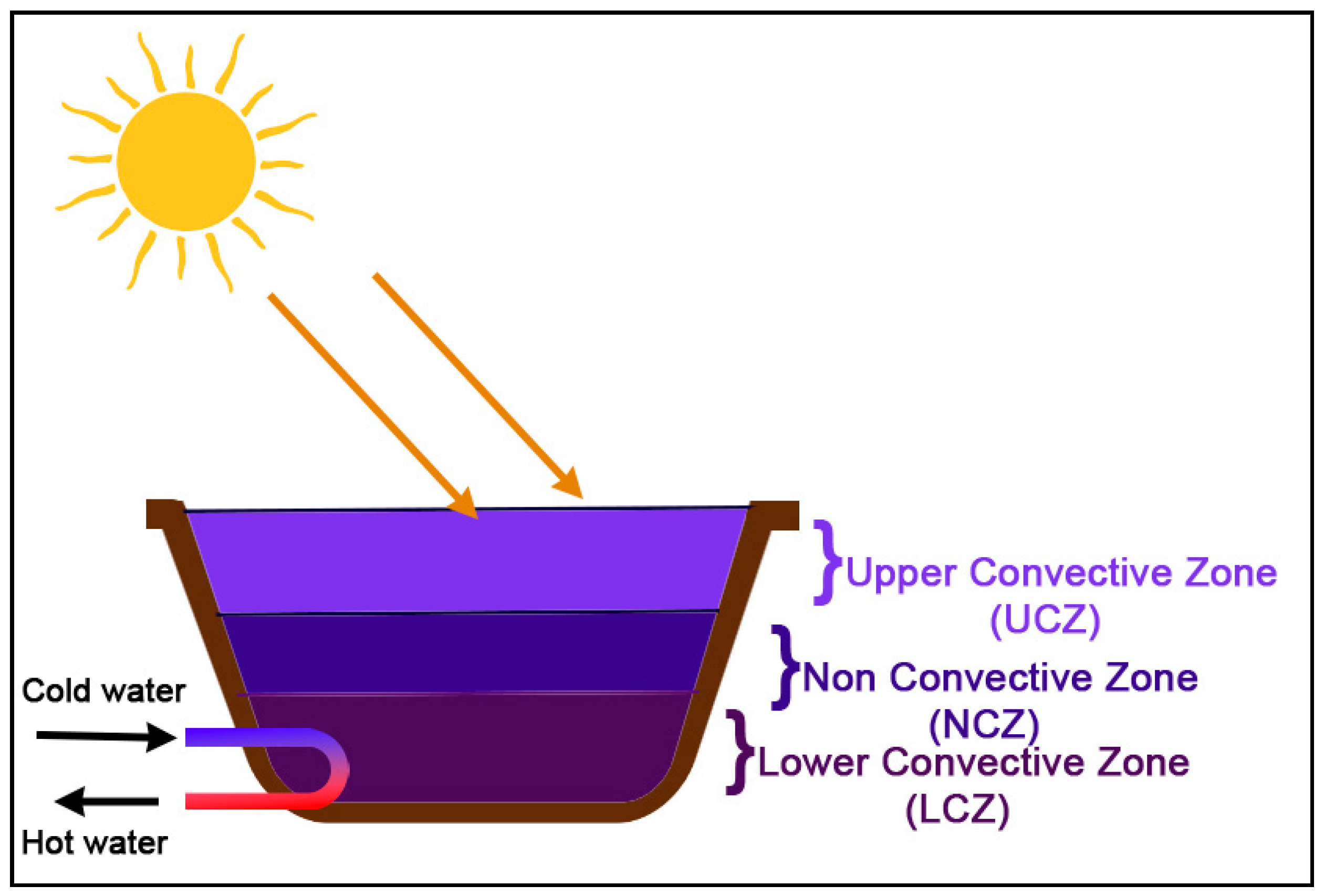
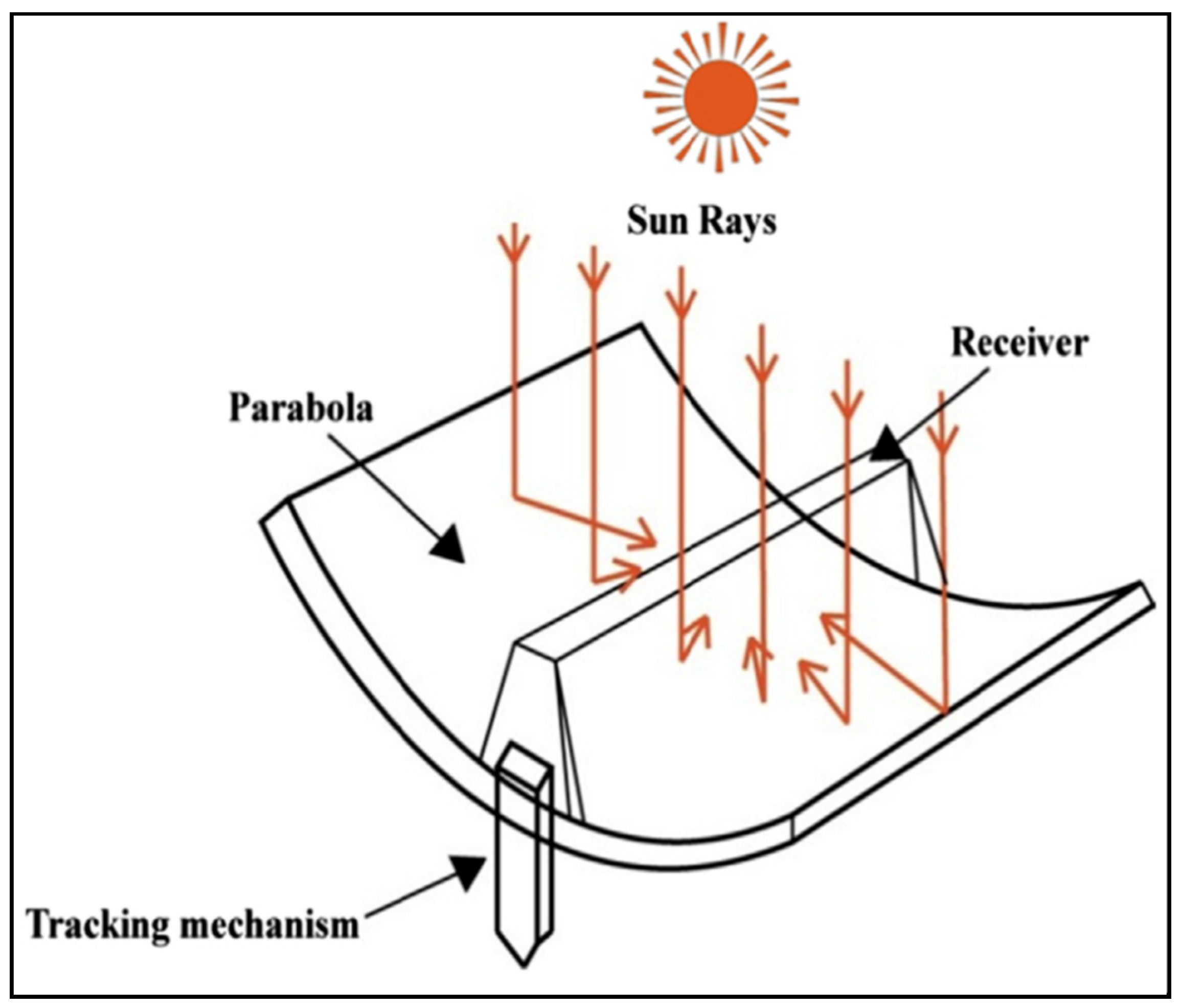
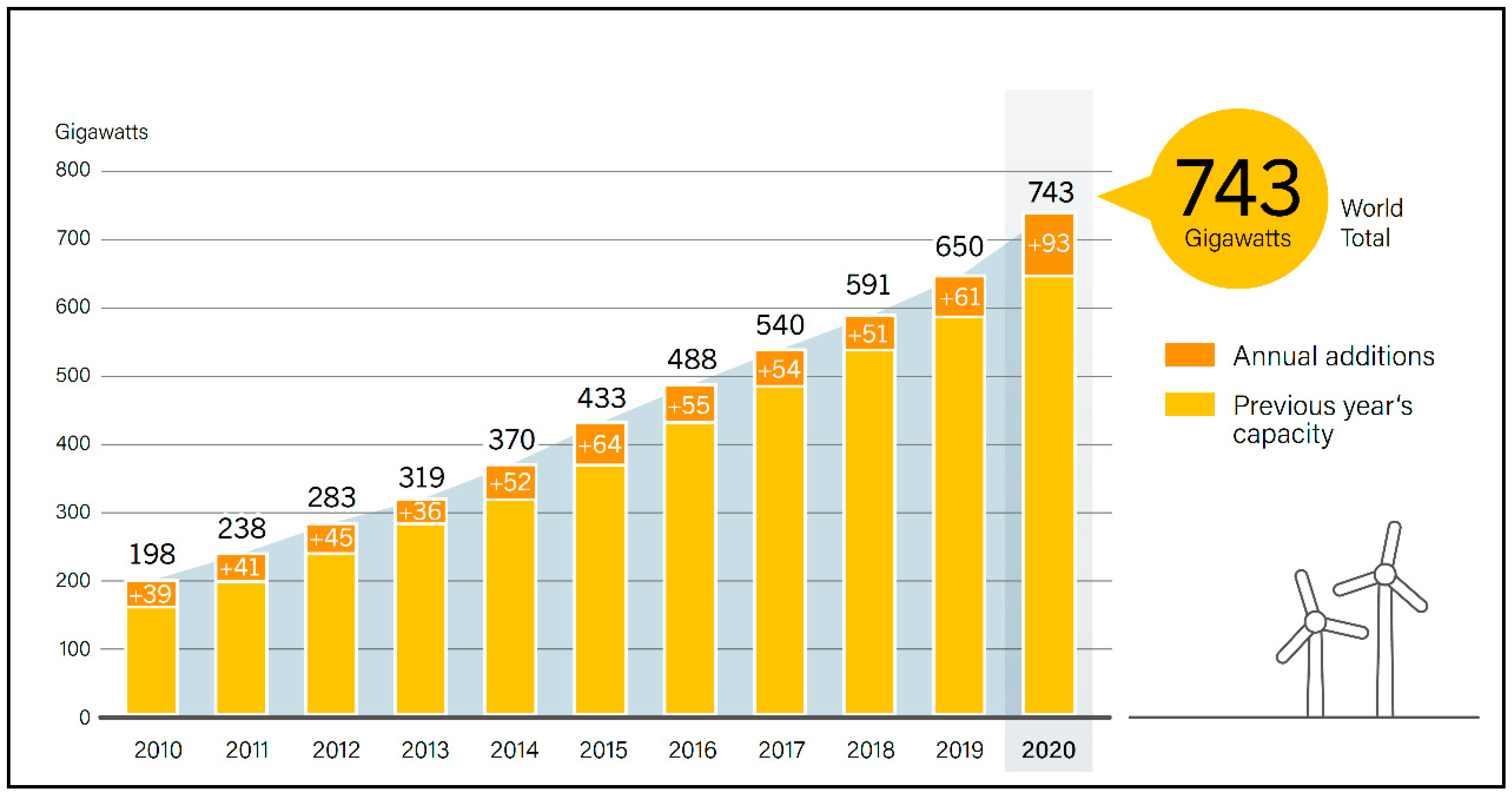

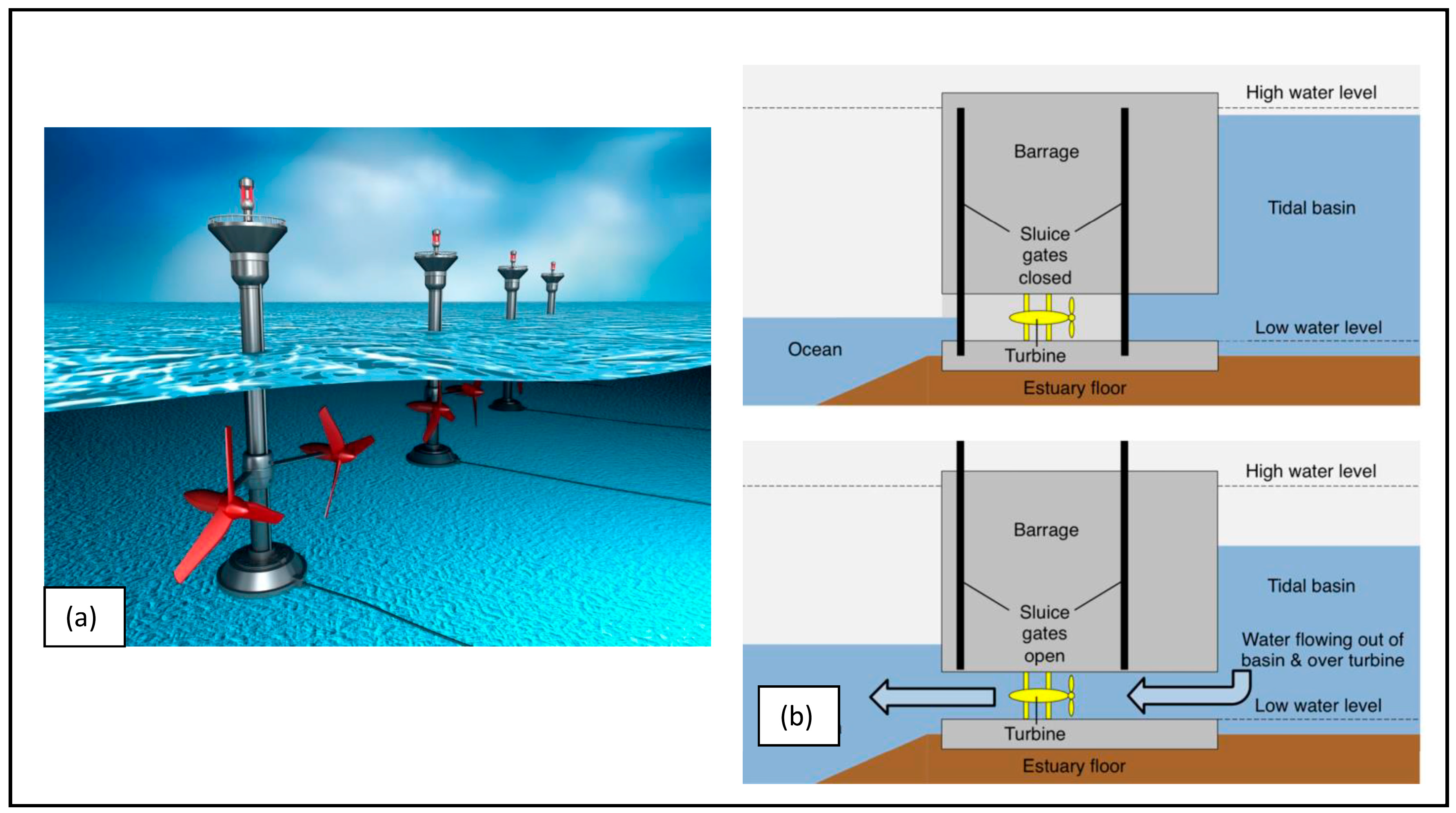
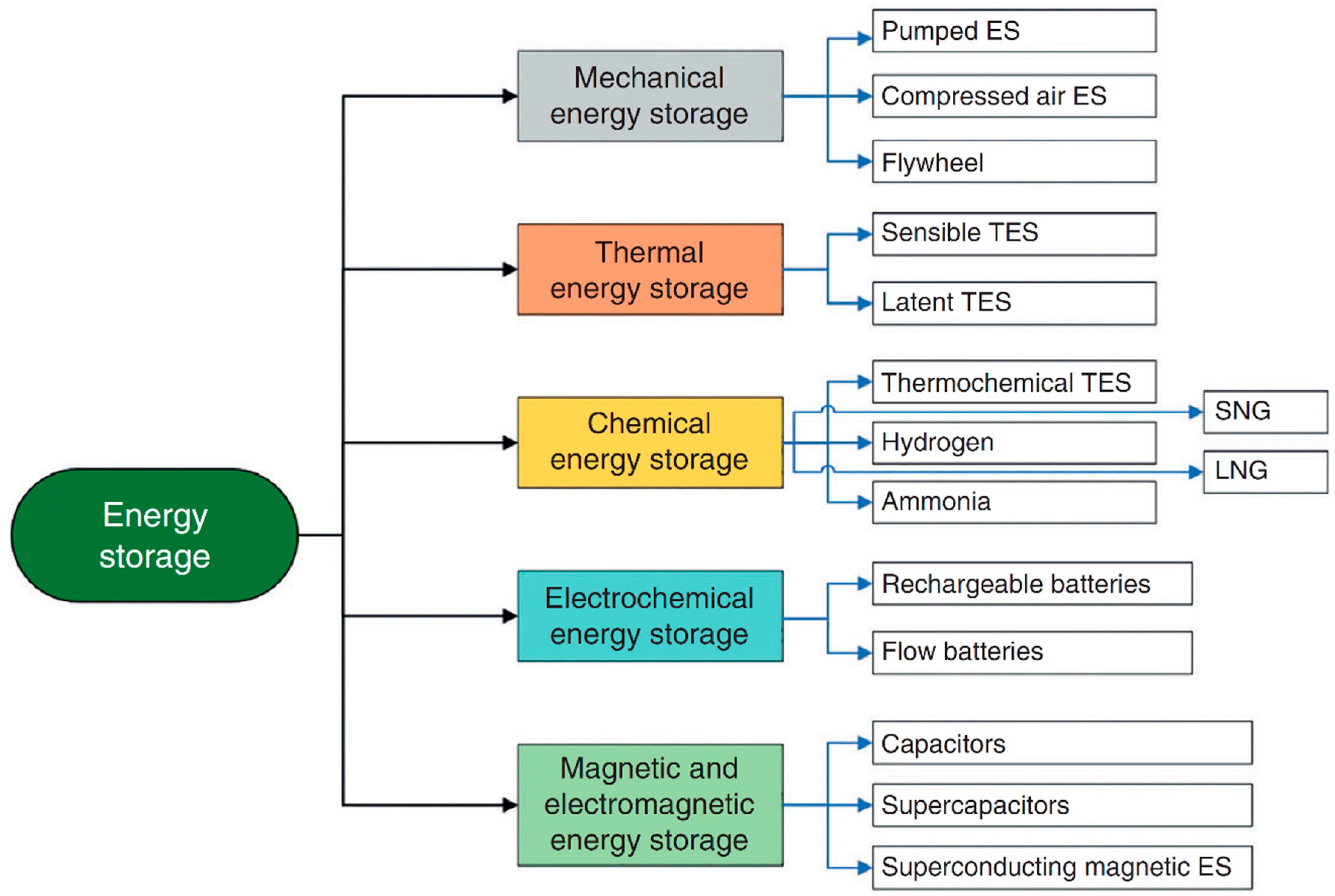


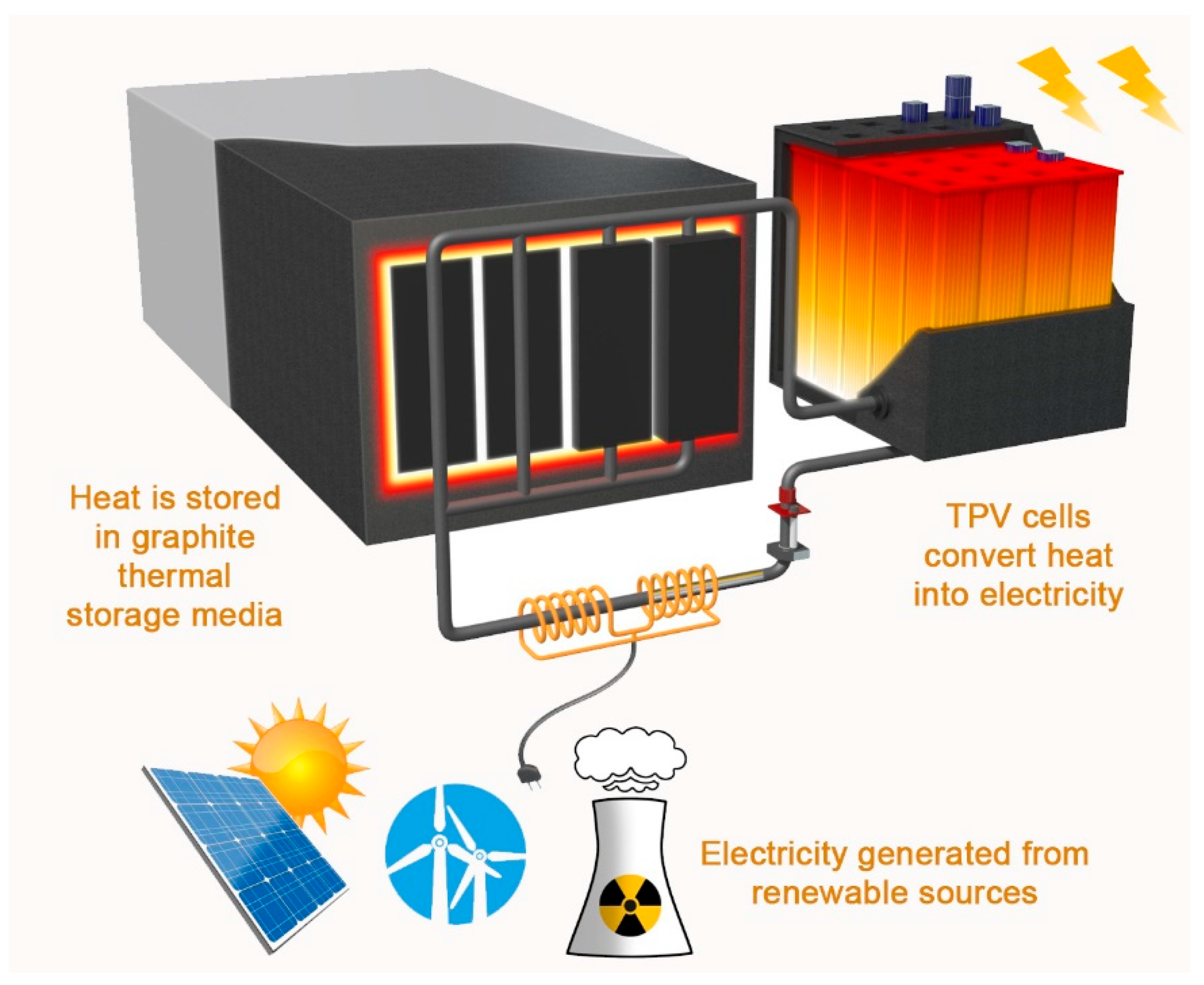
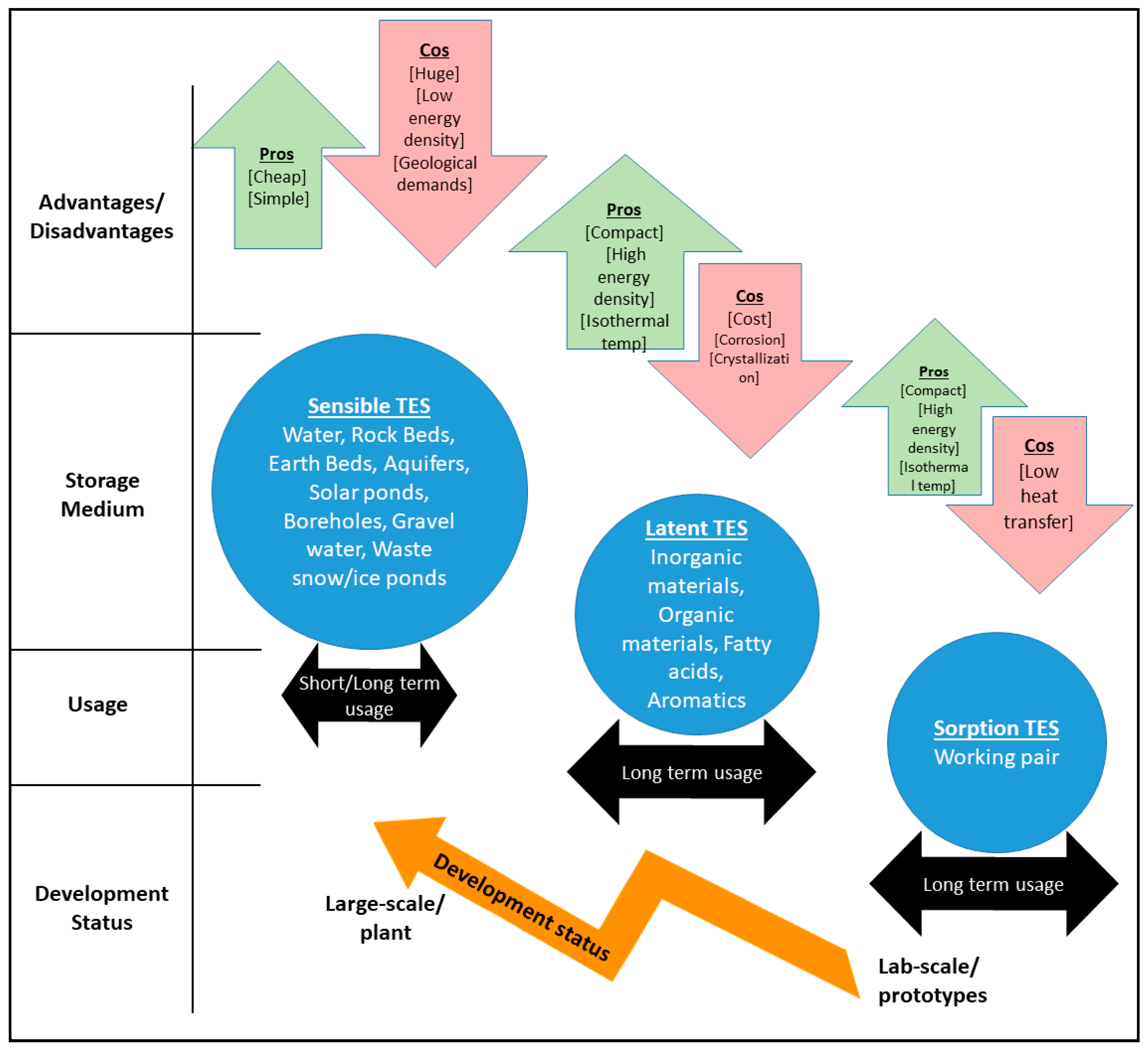
| Combined Renewable/TES System | Renewable System | Thermal Energy System | Work Type | Opportunities and Constraints | Reference |
|---|---|---|---|---|---|
| Solar/sensible TES | Parabolic-trough solar concentrator | Compressed CO2, | Original research/modeling | Opportunities: rising fossil-fuel prices, growing renewable energy demand, technological advancements Constraints: high investment cost, space requirement, weather vulnerability | [106] |
| Solar/sensible TES | “Concentrated solar power” (CSP) | “geothermal-based plate tectonic boundaries” | Original research/modeling | Opportunities: increasing demand for hydrogen, dual purpose of CSP systems (electricity and heat), reliable and sustainable heat from geothermal systems Constraints: high cost of CSP systems, limited geothermal resources, environmental impacts of geothermal systems | [61] |
| Solar/sensible TES | Ambient solar radiation | Concrete mixtures/molten salt | Original research/modeling | Opportunities: efficient solar energy harnessing, concrete’s heat capacity and thermal conductivity, scalability and adaptability Constraints: requirement of a heat transfer system, limited scope of study (focuses on comparing the heat capacity and thermal conductivity of concrete as a filler material) | [111] |
| Solar/sensible TES | Ambient solar radiation | Aquifer | Original research/modeling | Opportunities: energy cost savings, carbon footprint reduction, improved comfort and wellbeing Constraints: lack of generalizability (conducted in a single hospital in Turkey), cost consideration, did not consider the environmental impact | [144] |
| Solar/latent TES | “Visible solar storage fabric” (VSSF) | “Azo-PCM@PS” nanocapsule and “Cs0.32WO3” nanoparticle | Original research/experiment | Opportunities: sustainable energy for wearable devices, versatile applications, environmental data collection Constraints: laboratory setting, early development stage, limited application suitability | [145] |
| Solar/latent TES | “Concentric solar power” (CSP) | Thermochemical water-splitting cycles | Original research/experiment | Opportunities: hydrogen production from renewable sources, diverse hydrogen applications, amelioration of climate change Constraints: theoretical model, early development stage, climate and location limitations | [146] |
| Solar/latent TES | Shell-and-tube heat exchanger with a transparent silica glass shell | Copper foam embedded in PCM | Original research/experiment | Opportunities: improved heat transfer capacity, better temperature uniformity, reduced melting time Constraints: scalability, availability, further research needed | [129] |
| Solar/sensible and latent TES | Hot air collectors | Sensible TES: packed bed TES (PBTES) using pebble stones Latent-TES: PCM using paraffin wax | Original research/experiment | Opportunities: increased energy efficiency, reduced drying time, preserved product quality, value of computational numerical modeling Constraints: research needs, implementation challenges | [101] |
| Wind/sensible TES | Wind power with wind turbines | “Thermal energy grid storage influenced by multijunction photovoltaics” (TEGS-MPV) | Original research/modeling | Opportunities: environmental benefits, optimization and sensitivity analysis, renewable energy utilization Constraints: validation, real-world implementation, geographic specificity | [147] |
| Wind and solar/variable TES and other energy storage systems | Wind power with wind turbines | “Compressed air energy storage” (CAES), “pumped hydroelectric storage”, and “sodium–sulfur batteries” | Original research/experiment | Opportunities: potential for wind and solar energy, various energy storage methods Constraints: technical limitations, fluctuating wind turbine output | [16] |
| Wind/sensible TES | Wind power with wind turbines | TES embedded inside wind turbine nacelles, with | Original research/thermodynamic analysis | Opportunities: increased energy efficiency, sustainable energy solutions, effective utilization of renewable energy Constraints: technical challenges and uncertainties in the development, need for detailed assessments | [148] |
| Biomass/latent TES | “Guar gum” | carbon aerogel for encapsulating “polyethylene glycol” (PEG) | Original research/experiment | Opportunities: improved solar–thermal energy conversion and storage, use of biomass materials, cost-effective energy solutions Constraints: achieving homogeneity, optimization of carbon aerogels | [130] |
| Biomass/sensible TES | Bioproducts | Different TES | Review | Opportunities: sustainable production of electricity, fuels, and chemicals, flexible renewable-based utility plants, economic and technological feasibility Constraints: limitation of biomass resources, complex conversion processes, environmental impacts, carbon release | [51] |
| Biomass/sensible TES | Wood pellet | TES reboiler tank | Original research/modeling | Opportunities: improving district heating systems, reducing costs and emissions Constraints: technical barriers, economic barriers, geographical and temporal barriers | [149] |
| Biomass and other sources/sensible TES | Biomass-powered combined heat and power systems | Different TES | Review | Opportunities: enhanced energy efficiency, reduced greenhouse gas emissions, new revenue streams, energy security, sustainable energy transition Constraints: sustainable biomass supply, efficient conversion technology | [43] |
| Geothermal/latent TES | “Geothermal district heating system” (GDHS) | Undefined TES | Original research/case study analysis | Opportunities: sustainable and renewable energy source, enhanced performance and reliability, informed decision making with multicriteria decision analysis Constraints: dimensioning the district heating system, efficiency and cost of thermal energy storage technologies | [150] |
| Geothermal/sensible TES | “High-temperature aquifer thermal energy storage” (HT-ATES) | Undefined TES | Original research/risk analysis | Opportunities: risk identification and mitigation, promoting sustainable energy solutions Constraints: limited data on HT-ATES systems, uncertainties in subsurface conditions, potential environmental impacts | [14] |
| Geothermal/sensible TES | “Mobile thermal storage system” (M-TES) | Undefined PMC | Original research/techno-economic assessment | Opportunities: renewable and stable energy source, high-capacity factors, mobile thermal energy storage Constraints: climate factors | [141] |
| Ocean/sensible TES | “Ocean thermal energy conversion” system (OTEC) | Undefined TES | Original research/modeling | Opportunities: improved control strategies, renewable energy for islands, enhanced efficiency and effectiveness Constraints: limited controller comparison | [94] |
| Ocean/sensible TES | Ocean energy | Undefined TES | Review | Opportunities: advanced ocean energy converters, diversified ocean energy systems and hybrid energy storage, artificial intelligence integration, complementary hybrid renewable system integrations Constraints: power frequency fluctuation | [151] |
| Ocean/latent TES | Ocean thermal energy | Different PMC | Review | Opportunities: utilization of ocean thermal energy, PCM thermal-harvesting systems Constraints: slow heat transfer rates, low conversion efficiency, low energy storage density, conceptual design phase | [15] |
| Poly: solar-geothermal/sensible TES | “Enhanced geothermal energy” (EGS) and “concentrated solar power” (CSP) | Undefined TES | Original research/case study analysis | Opportunities: continuous energy production, integration of thermal energy storage, sustainable and green alternative, improved techno-economic performances Constraints: harnessing geothermal energy, solar intermittency, large-scale land use | [152] |
| Poly: ocean and solar/latent TES | “Concentrated solar plant” (CSP), a “bifacial photovoltaic” (BiPV), a “cascaded heat pump”, and a “multieffect desalination” process | “Polymer electrolyte membrane” (PEM) electrolyzer, fuel cell systems, and thermal energy storage systems | Original research/case study analysis | Opportunities: renewable energy utilization, integrated hydrogen production and thermal energy storage, combining food production systems, quality of life improvement Constraints: harsh arctic conditions, system optimization | [107] |
| Poly: solar, wind, and ocean/TES | “Ocean thermal energy convertor” (OTEC), a wind turbine, and a “solar flat plate panel” | Undefined TES | Original research/case study analysis | Opportunities: sustainable and efficient energy system, reduced dependence on fossil fuels, contribution to energy security Constraints: geographical specificity, substantial initial investment and infrastructure development, intermittency of renewable energy sources | [153] |
| Geothermal and solar/latent TES | A solar-geothermal hybrid system | CO2 cycle with an organic Rankine cycle and heat exchangers | Original research/thermodynamic analysis | Opportunities: efficient utilization of renewable resources, reliability and flexibility in energy supply, improved thermodynamic performance, optimization of system configurations Constraints: high initial capital costs, geographical and climatic dependency, availability of suitable materials and technologies for thermal energy storage, technical challenges with the transcritical CO2 Cycle | [114] |
| Geothermal and solar/sensible TES | ATES combined with solar collectors | Undefined TES | Original research/case study analysis | Opportunities: enhanced energy efficiency, reduced environmental impact, cost-effective integration of renewable energy sources Constraints: technical challenges, regulatory barriers, dependence on local conditions | [112] |
| Geothermal and solar/sensible TES | Solar energy system powered by geothermal | Organic Rankine cycle | Original research/thermodynamic analysis | Opportunities: enhanced energy efficiency, reduced dependence on fossil fuels, improved ORC performance Constraints: geographical limitations, high initial costs, intermittency of solar energy | [105] |
| RE–TES Option | Efficiency | Cost-Effectiveness | Scalability | Environmental Impact | References |
|---|---|---|---|---|---|
| Solar systems with battery storage | Moderate (15–20%) | Moderate–high (depending on battery type) | Moderate–low (limited by battery capacity) | Low (no emissions during operation, but batteries require rare Earth metals and other materials) | [61,101,105,106,111,112,114,129,144,145,146,153] |
| Wind turbines with pumped hydro storage | High (30–50%) | High (long lifespan of hydro storage infrastructure) | High (can be scaled up to meet large energy demands) | Moderate (construction of hydro storage infrastructure can have environmental impacts, but the operation is low-impact) | [16,147,148,153] |
| Geothermal power with thermal energy storage | High (70–90%) | Moderate–high (depending on location and drilling costs) | Low–moderate (limited by geothermal resources in certain areas) | Low–moderate (minimal emissions during operation, but drilling can have environmental impacts) | [14,105,112,114,141,150] |
| Biomass power with thermal energy storage | Moderate (20–30%) | Low–moderate (depending on feedstock availability and cost) | Low–moderate (limited by feedstock supply) | Moderate–high (emissions from biomass combustion can contribute to air pollution and climate change, but sustainable sourcing can mitigate some impacts) | [43,51,130,137,149] |
| Ocean energy with thermal energy storage | Low–moderate (10–20%) | Moderate (infrastructure can be costly, but operational costs are low) | High (especially in coastal regions with consistent wave/tidal action) | Low–moderate (potential impact on marine ecosystems during construction, but operation is low-impact) | [15,94,107,151] |
| Simulation/Method | Description | References |
|---|---|---|
| Artificial neural networks (ANNs) | This machine learning tool is used to model and predict the behavior of systems based on training data. It was used in some studies to develop predictive models for the performance of solar collectors and TES systems. | [154] |
| EnergyPlus | This building energy simulation program is used to model and simulate the energy performance of buildings. It was used in some studies to analyze the performance of building integrated renewable energy systems and TES systems. | [155,156] |
| MATLAB/Simulink | This numerical computing tool is used for mathematical modeling, simulation, and analysis of dynamic systems. It was used in some studies to model and simulate the behavior of solar thermal systems and TES systems. | [153,157,158] |
| System dynamics modeling | This simulation tool is used to model complex systems’ behavior over time. It was used in some studies to simulate the behavior of renewable energy systems and thermal energy storage systems. | [159,160] |
| TRNSYS (Transient System Simulation Tool) | This dynamic simulation tool is used to model and simulate the performance of renewable and thermal energy storage systems. It was used in some studies to analyze the performance of different solar collectors and TES systems. | [161,162] |
| Parameters/Term | Description |
|---|---|
| Biomass | Organic matter, such as wood, crops, or animal waste, can be used as fuel for heating or electricity generation. |
| Concentrated solar power (CSP) | A technology that uses mirrors or lenses to concentrate sunlight onto a small area, which heats a fluid to produce steam and generate electricity. |
| Di-generation | A system that generates two forms of energy, usually electricity and heat, from a single energy source. |
| Enhanced geothermal systems (EGS) | A type of geothermal energy production involves creating artificial fractures in hot rock formations to extract heat from the Earth. |
| Latent thermal energy storage (LTES) | A type of TES that stores energy by changing the phase of a material, such as melting or solidifying. |
| Model predictive control (MPC) | A control strategy that uses a mathematical model to predict future behavior of a system and optimize control actions accordingly. |
| Ocean energy | Energy derived from the ocean, including ocean waves, tides, ocean currents, thermal ocean energy, and chemical ocean energy. |
| Ocean thermal energy conversion (OTEC) | A technology that harnesses the temperature difference between warm surface water and cold deep water to generate electricity. |
| Organic Rankine cycle (ORC) | A thermodynamic cycle that uses an organic fluid as the working fluid in a closed loop to generate electricity. |
| Oscillating water columns | A type of ocean wave energy converter that uses waves to compress and decompress air in a chamber, which then drives a turbine to generate electricity. |
| Overtopping wave energy converters | A type of ocean wave energy converter that uses waves to fill a reservoir with water, which is then released through a turbine to generate electricity. |
| Phase change materials (PCMs) | Substances that store and release thermal energy during phase transitions commonly used in thermal energy storage systems for heating, cooling, and air conditioning applications. |
| Polymer electrolyte membrane (PEM) electrolyzer | A device that uses an electric current to split water into hydrogen and oxygen gases. |
| Proportional integral (PI) control | A control strategy that adjusts a system’s output based on the difference between the desired set point and the actual value, using proportional and integral terms. |
| Renewable energy sources (RES) | Energy sources such as solar, wind, hydro, geothermal, and biomass replenished naturally and sustainably. |
| Sensible thermal energy storage (STES) | A type of TES that stores energy by changing the temperature of a material without changing its phase. |
| Solar parabolic trough collectors | A type of solar thermal technology that uses curved mirrors to concentrate sunlight onto a pipe containing a heat transfer fluid, which is then used to generate steam and produce electricity. |
| Thermal energy storage (TES) | A method of storing thermal energy by heating or cooling material to retrieve the energy later for heating or cooling purposes. |
| Tri-generation | A system that generates three forms of energy, usually electricity, heat, and cooling, from a single energy source. |
Disclaimer/Publisher’s Note: The statements, opinions and data contained in all publications are solely those of the individual author(s) and contributor(s) and not of MDPI and/or the editor(s). MDPI and/or the editor(s) disclaim responsibility for any injury to people or property resulting from any ideas, methods, instructions or products referred to in the content. |
© 2023 by the authors. Licensee MDPI, Basel, Switzerland. This article is an open access article distributed under the terms and conditions of the Creative Commons Attribution (CC BY) license (https://creativecommons.org/licenses/by/4.0/).
Share and Cite
Elkhatat, A.; Al-Muhtaseb, S.A. Combined “Renewable Energy–Thermal Energy Storage (RE–TES)” Systems: A Review. Energies 2023, 16, 4471. https://doi.org/10.3390/en16114471
Elkhatat A, Al-Muhtaseb SA. Combined “Renewable Energy–Thermal Energy Storage (RE–TES)” Systems: A Review. Energies. 2023; 16(11):4471. https://doi.org/10.3390/en16114471
Chicago/Turabian StyleElkhatat, Ahmed, and Shaheen A. Al-Muhtaseb. 2023. "Combined “Renewable Energy–Thermal Energy Storage (RE–TES)” Systems: A Review" Energies 16, no. 11: 4471. https://doi.org/10.3390/en16114471
APA StyleElkhatat, A., & Al-Muhtaseb, S. A. (2023). Combined “Renewable Energy–Thermal Energy Storage (RE–TES)” Systems: A Review. Energies, 16(11), 4471. https://doi.org/10.3390/en16114471







